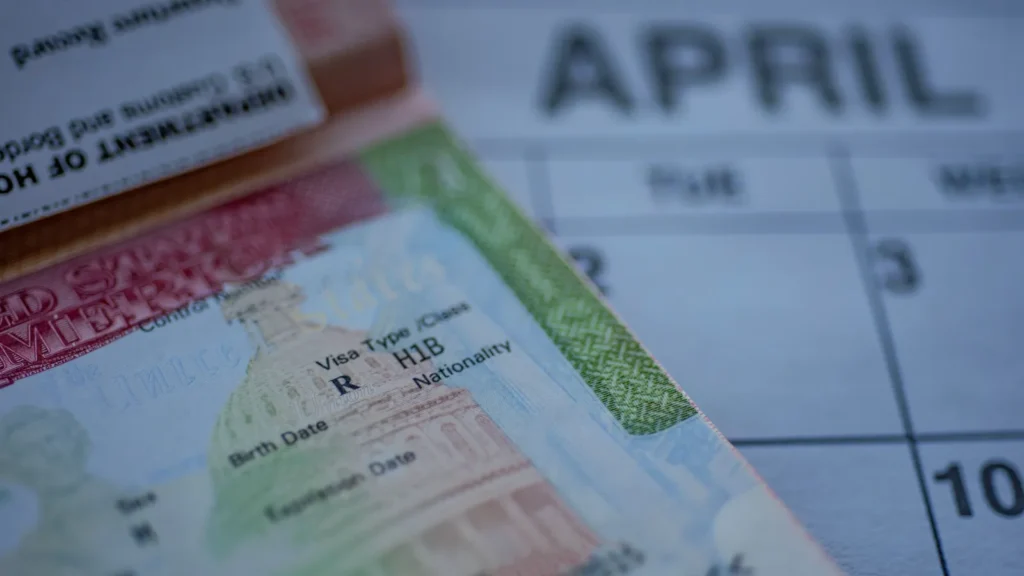H-1B Visa is one of the most important nonimmigrant visas for foreign professionals who want to work in the United States. It allows U.S. employers to hire skilled workers in specialized fields like technology, engineering, finance, law, and medicine. Every year, tens of thousands of applicants compete for this visa through a lottery system due to its high demand and limited availability.

What Is the H-1B Visa?
The H-1B visa is a nonimmigrant work visa granted by U.S. Citizenship and Immigration Services (USCIS). It is specifically designed for workers in “specialty occupations”—jobs that require at least a bachelor’s degree or equivalent professional experience in a specialized field.
- Duration: Initially valid for 3 years, renewable up to 6 years.
- Employer-tied: You can only work for the sponsoring employer.
- Family benefits: Spouses and children under 21 can accompany the worker on an H-4 visa, with certain work and study rights.
- Green Card pathway: Many H-1B holders later transition to permanent residency (Green Card).
The visa serves as a bridge for U.S. companies to access global talent when local supply is insufficient.
Who Is Eligible for an H-1B Visa?
Both the employee and the employer must meet specific requirements:
Worker Requirements
- A U.S. bachelor’s degree or higher (or foreign equivalent).
- Demonstrated specialized knowledge in the field (e.g., IT, engineering, law, architecture, finance, healthcare).
- A valid job offer from a U.S. employer.
Employer Requirements
- Must prove the role is a specialty occupation.
- Offer a prevailing wage as determined by the Department of Labor.
- File all necessary documentation (Labor Condition Application, petition forms, etc.).
H-1B Visa Lottery and Cap
Because the demand for H-1B visas far exceeds the annual limit, USCIS uses a lottery system:
- Regular Cap: 65,000 visas annually.
- Master’s Cap (Advanced Degree Exemption): Additional 20,000 visas reserved for applicants with U.S. master’s or higher degrees.
In most years, USCIS receives more than 400,000 applications, meaning selection is highly competitive.
Step-by-Step H-1B Visa Application Process
Here’s how the process typically unfolds:
- Employer Registration in the Lottery (March):
Employers register online to enter workers into the lottery. - Lottery Selection (April):
USCIS randomly selects candidates to proceed. - Labor Condition Application (LCA):
Employer files LCA with the Department of Labor to prove fair wages and no negative impact on U.S. workers. - Petition Filing (Form I-129):
Employer submits a petition with USCIS, including proof of qualifications and the job offer. - USCIS Review and Approval:
If approved, the worker can proceed to visa stamping at a U.S. consulate. - Visa Stamping and Entry:
After approval, the worker applies for a visa interview at a U.S. embassy/consulate and, upon approval, enters the U.S. to begin work.
H-1B Visa Costs (2025)
The employer typically covers most of the costs. Fees include:
| Fee Type | Amount (Approx.) | Who Pays |
|---|---|---|
| Registration Fee | $10 | Employer |
| Filing Fee (Form I-129) | $460 | Employer |
| ACWIA Training Fee | $750–$1,500 | Employer |
| Fraud Prevention Fee | $500 | Employer |
| Public Law Fee (if applicable) | $4,000 | Employer |
| Premium Processing (optional) | $2,805 | Employer/Employee |
Benefits of the H-1B Visa
- Work legally in the U.S. in a specialty occupation.
- Earn competitive salaries.
- Bring family on H-4 visas.
- Pathway to a Green Card.
- Opportunity to gain international career experience.
Challenges and Common Reasons for Denial
- Not meeting degree or specialization requirements.
- Incomplete or inaccurate documentation.
- Employer failing to meet Department of Labor standards.
- Role not qualifying as a “specialty occupation.”
Tips to Improve Your Chances of Getting an H-1B Visa
- Pursue higher education in the U.S. to qualify for the Master’s Cap.
- Work with experienced employers who regularly sponsor H-1B visas.
- Prepare documentation early (degrees, transcripts, professional licenses, translations).
- Use premium processing if time-sensitive.
- Network with companies in high-demand industries (IT, healthcare, finance).
Alternatives to the H-1B Visa
If you don’t win the lottery, there are alternatives:
- L-1 Visa: For intra-company transfers.
- O-1 Visa: For individuals with extraordinary ability.
- TN Visa: For Canadian and Mexican professionals under USMCA.
- F-1 OPT Extension: For international students in STEM fields.
The H-1B visa remains one of the most sought-after routes for skilled workers who want to build their careers in the U.S. While the process is competitive and complex, thorough preparation, working with experienced employers, and pursuing advanced U.S. education can significantly improve your chances.





